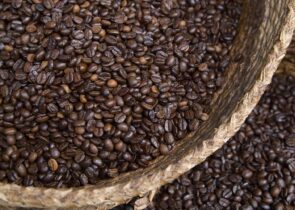Siphon coffee makers have to be the coolest thing in the coffee world. These coffee makers have been around since the 1830s and were initially used to teach scientific principles.
It’s a literal science experiment that makes coffee; how cool is that?! If you want more information about the history of siphon coffee brewers, check out my article, What is Siphon Coffee? Everything you need to know.
I’ve spent the past six months learning this coffee maker’s ins and outs, and now it’s time to pass the knowledge on to you. So grab some goggles and a lab coat, get your best Bill Nye impression ready, and let’s make some coffee.

Things you’ll need
- Grinder
- Scale
- Siphon brewer and everything that comes with it
- A heat source
- Timer
- Something to stir the coffee
- A small cup to measure and hold the ground coffee
- Lab coat and goggles
Step 1: Soak the filter (skip this step if you’re using a paper filter)
Let’s start by ensuring that our cloth filter is ready to brew. Place the cloth filter in a cup of warm water, ensuring it is completely submerged. Let it soak for about five minutes.
Step 2: Measure the coffee
Let’s get our coffee measured while we wait for our coffee filter to be ready. Place the small cup on your coffee scale and zero it out. For this recipe, we will use 35 grams of ground coffee. If you aren’t sure what beans to get for your next cup, check out my rundown of the Best Coffee Beans for Siphon Brewing.
Step 3: Grind that coffee
Now that we have the right amount of coffee, it’s time to grind it. We are looking for a medium-fine grind or beach sand consistency. You’ll want to be around a #13 if you use a Barazta Encore.
Step 4: Attach the Filter
With our coffee and filter prepped, it’s time to attach our filter. First, run the chain down the tube in the upper chamber, placing the filter at the bottom.
Grabbing the chain, gently pull down until the hook can be attached to the bottom of the tube, and make sure the filter is centered.
If you turn over the lid that comes with the brewer, you’ll find a little stand for the top chamber. Place it in the stand while we get the bottom chamber ready.
Step 5: Add the water
Place the bottom chamber on the scale and zero it out. We will weigh out 560 grams of pre-heated water that we boiled in a kettle earlier and set aside. You can use room temperature water, but it will take longer for the hot water to come to an initial boil.
Step 6: Hot Hot Heat
Now that we have our bottom chamber filled with water, let’s get it onto our heat source. If your brewer came with a separate burner, place it under the bottom chamber. If you’re using a stovetop brewer, go ahead and place it on your burner.
Regardless of your heat source, you want to bring the water to a boil.
Step 7: Attach the top chamber to the bottom
Once the water begins to boil, gently attach the top chamber to the bottom, ensuring that the rubber seal is completely seated in the bottom chamber. The seal here allows the vacuum to be made in the bottom chamber to pull the boiling water to the top chamber.
If you see some water left in the bottom chamber, don’t worry; this is normal.
Step 8: Reduce the heat
Once the top chamber is filled, reduce the heat until the water is no longer boiling but doesn’t begin draining to the bottom chamber.
Step 9: Add the Coffee
Now that the water is cooler (195ºF to 205ºF), it is time to add the coffee we measured out earlier. Set the time for 30 seconds and dump the coffee into the top chamber.
Once the coffee is in the water, start the timer and use whatever you have at hand to gently push down the coffee and ensure that everything is just saturated. After the 30 seconds are over, gently re-submerge the coffee.
Step 10: Let it brew
Set the timer for one minute and 10 seconds. Keep an eye on the coffee during that time, and ensure that the water stays in the top chamber and isn’t coming to a rolling boil. Temperature control here is key to a great finished product.
Step 11: Remove from the heat
Remove the brewer from the heat when the timer goes off. At the same time, gently stir the coffee ten times.
Step 12: Let it cool
The coffee from the top will slowly filter to the bottom chamber as the bottom chamber begins to cool.
If you’ve done it right, you should be left with a dome of coffee grounds over the filter in the top chamber. Remove the top chamber and place it back on the stand.
Give the coffee a few minutes to cool before you serve it, and you’re good to go.
Cleaning up
Now that all the fun stuff is out of the way, we need to talk about how to care for your brewer. If your siphon coffee brewer came with a cloth filter, you must know how to store it. This little guy needs a little more work to keep your final coffee brew tasting fresh and clean.
Give your filter a quick rinse with warm water and dish soap. If your filter looks like it’s been stained from the coffee, you can let it soak in a 2:1 white vinegar-to-water solution or a coffee detergent. Soaking your filter will help to remove any oils that might be left over.
Once it’s looking nice and clean, you want to store it submerged in water in an air-tight container in your refrigerator. This helps keep the filter from getting moldy in between brews.
Temperature Control
Temperature control is one of the most important factors in making a great cup of siphon coffee and one of the few things we can change throughout the brewing process.
So why is it so important?
Well, for a few reasons. We want to ensure that the coffee isn’t agitated by a rolling boil. This can cause the coffee to become over-extracted and taste bitter. The water’s heat can also just burn the coffee outright.
If you’ve ended up with a cup of coffee that tastes like burnt peanuts, your water probably got too hot at some point during brewing.
Conversely, if we let the water cool too much, we won’t have the pressure needed to keep the water in the top chamber. This will lead to an underdeveloped and sour final cup of coffee.
So how do you stop this? You can grab a thermometer and make sure that the water in the top chamber stays between 195 to 205 degrees Fahrenheit after you reduce the heat. Or, just keep a close eye on your coffee as it brews.
Using a thermometer to measure the water temperature when brewing siphon coffee is a good way to calibrate yourself to what certain water temperatures look like. As you become more experienced, you probably won’t use it as much.
What is the Ideal Grind for Siphon Coffee?
In this recipe, we used a medium-fine grind. This will give you a great cup of coffee as the water has just the right amount of surface area to extract from. But like most things in coffee, there is always room for experimentation, which makes coffee so much fun.
Do you like this recipe but find that the coffee is a little too watery for you? Well, then, go a little finer next time. The finer grind makes it easier for the water to absorb more of the water-soluble flavors and caffeine in the coffee, giving you a much more robust cup.
Do you think the coffee is a little too strong and want something lighter? Then you need a coarser grind. The coarser grind means less coffee is in contact with the water, and you get a lighter cup of coffee.
Part of the fun is trying new things, seeing what that does to the final cup of coffee, and finding what you like. So, grab your grinder and try all the settings it has. But be careful with going too coarse or too fine as that can lead to something that won’t taste the best.
What is the Golden Ratio for Coffee to Water?
The golden ratio is more of a range of coffee-to-water ratios that start at 1:15 and goes up to 1:18. Can you find coffee that you like outside of these limits?
Absolutely, you can. But these numbers are great when you’ve got a new brewer and have no idea how much coffee you should use.
This range is the sweet spot between coffee that is overpowering from too much coffee and not enough water. Or coffee that is a weak and dull tasting from too little coffee and too much water.
Our recipe falls into this range at a 1:16 ratio. For reference, espresso usually uses a 1:2 coffee-to-water ratio, giving you a powerful and robust coffee flavor.
This range is a great starting point when making coffee in a brewer.
Happy Caffeinating!







